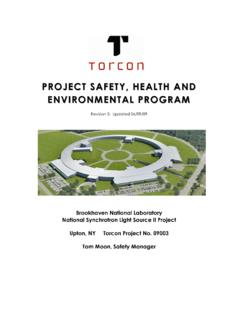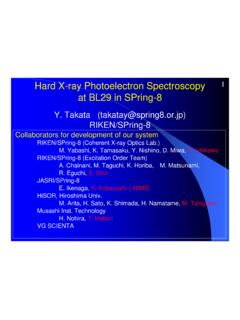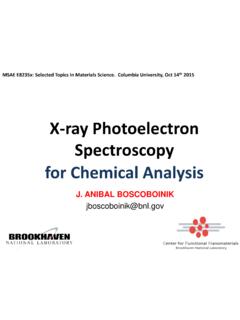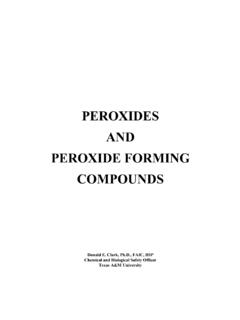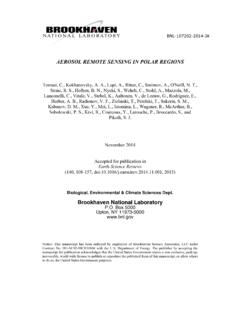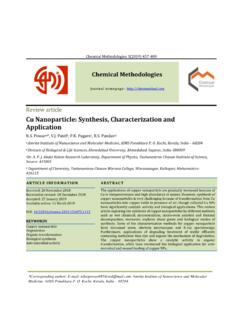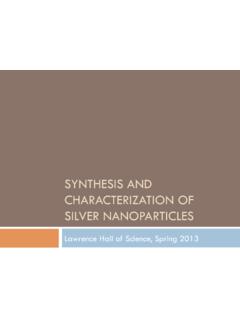Transcription of Hydrogenation of CO2 to Methanol: Importance of Metal ...
1 Hydrogenation of CO2 to Methanol: Importance of Metal -Oxide and Metal -Carbide Interfaces in the Activation of CO2 Jos A. Rodriguez*, Ping Liu, Dario J. Stacchiola, Sanjaya Senanayake, Michael G. White and Jingguang G. Chen Chemistry Department Brookhaven National Laboratory Upton, NY 11973, USA Abstract The high thermochemical stability of CO2 makes very difficult the catalytic conversion of the molecule into alcohols or other hydrocarbon compounds which can be used as fuels or the starting point for the generation of fine chemicals.
2 Pure metals and bimetallic systems used for the CO2 CH3OH conversion usually bind CO2 too weakly and, thus, show low catalytic activity. Here, we discuss a series of recent studies that illustrate the advantages of Metal -oxide and Metal -carbide interfaces when aiming at the conversion of CO2 into methanol. CeOx/Cu(111), Cu/CeOx/TiO2(110) and Au/CeOx/TiO2(110) exhibit an activity for the CO2 CH3OH conversion that is 2-3 orders of magnitude higher than that of a benchmark Cu(111) catalyst. In the Cu-ceria and Au-ceria interfaces, the multifunctional combination of Metal and oxide centers leads to complementary chemical properties that open active reaction pathways for methanol synthesis .
3 Efficient catalysts are also generated after depositing Cu and Au on TiC(001). In these cases, strong- Metal support interactions modify the electronic properties of the admetals and make them active for the binding of CO2 and its subsequent transformation into CH3OH at the Metal -carbide interfaces. * Corresponding author, e-mail: fax: 1-631-344-5815 Keywords: CO2 activation, CO2 Hydrogenation ; methanol synthesis ; reverse water-gas shift reaction; Metal oxides; Metal carbides; copper; goldBNL-108509-2015-JA 1 I. Introduction Carbon dioxide (CO2) is a major air pollutant released into the atmosphere by the combustion of carbonaceous fuels, principally wood, coal, oil derived combustibles and natural ,2 A rising concentration of CO2 in the Earth s atmosphere has led to concerns about global climate changes and the possible ocean acidification.
4 In the last decade, the chemistry of CO2 has received significant attention due to its potential use as an alternative and economical ,4,5 The Hydrogenation of CO2 to alcohols or other hydrocarbon compounds is an important approach for recycling the CO2 released to the atmosphere in combustion Due to a continuous increase in the industrial demand for methanol, much effort is now being devoted to the conversion of CO2 to In principle, the chemical recycling of CO2 to methanol can provide a renewable, carbon-neutral, source for the production of fuels, a practical way for the storage and transportation of energy, as well as a convenient feedstock for producing olefins such as ethylene and propylene and from them synthetic products of interest in the chemical ,7,8 The Hydrogenation of CO2 to methanol and water CO2 + 3H2 CH3OH + H2O (1) is an exothermic reaction at room temperature ( H298 K= - kcal/mol)
5 , but it competes with the methanation reaction ( H298 K= kcal/mol)9 CO2 + 4H2 CH4 + 2H2O (2) Thus, a high selectivity towards methanol formation requires the use of catalysts that are able to adsorb and activate CO2 but do not break both C-O bonds in the molecule. Furthermore, because H and S are both negative in equation (1), the synthesis of 2methanol is potentially equilibrium limited a high temperature and ideally one must look for catalyst that operate in an efficient way at temperatures below 450 , 10 With these constrains in mind, different types of materials have been tested as catalysts for the CO2 CH3OH ,4,7,11,12,13,14 Most of the catalysts used in the industry involve Metal nanoparticles supported on an oxide ,10 Cu-based catalysts, which also contain ZnO and/or Al2O3.
6 Have been commercially used for more than 50 ,10 They do not cleave both bonds in the molecule, no methane formation through equation (2), but exhibit poor activity for CO2 Hydrogenation at low temperature (T < 500 K).7,15 An increase in temperature facilitates CO2 activation, but undesirable CO and H2O are formed through the reverse water-gas shift reaction (RWGS) CO2 + H2 CO + H2O (3) As a result, additional H2 is consumed and methanol production is , 16 Furthermore, the presence of water accelerates the sintering of Cu and ZnO in the catalysts leading to ,17 One can try to improve the performance of Cu-based catalysts by making alloys of Cu and a second Metal ,4,18,19 but more active and stable catalysts have been obtained recently after depositing copper on novel mixed- Metal oxides or on Metal .
7 13 Metal oxides are frequently used as supports for the dispersion of metals and their ability to bind and activate CO2 largely depends on their basicity and ,20,21,22 Reduced oxides have a strong tendency to react with ,19 By stabilizing the reduced states of an oxide one can enhance its surface chemistry and catalytic activity for CO2 The stabilization of the reduced states can be achieved by forming oxide- Metal or oxide-oxide , 24 , 25 , 26 , 27 For example, experimental and theoretical 3studies for the CeOx/Cu and CeOx/TiO2 systems have shown that at small coverages of ceria, the ceria nanoparticles favor a +3 oxidation ,29,30,31 Furthermore, in an oxide- Metal interface, in addition to the changes in the reducibility of the oxide, one can also observe a perturbation in the electronic properties of the , 33 , 34 , 35 , 36 Electronic perturbations can also occur after forming a carbide- Metal ,38,39 In principle.
8 The special synergistic properties associated with oxide- Metal and carbide- Metal interfaces can be useful for preparing efficient catalysts for CO2 ,40,41,42,43 In this Perspective article, we present an overview of recent systematic studies for the conversion of CO2 to methanol on Cu or Au centers dispersed on oxide and carbide supports. We will start by examining the interaction of CO2 with extended surfaces and nanoparticles of ,11,19,44-49 This will allow us to analyze the difficulties associated with the activation of CO2 and the subsequent CO2 CH3OH transformation.
9 Then, we will focus on more complex systems: CO2 Hydrogenation on Metal -oxide and Metal -carbide We will pay particular attention to cooperative or synergistic effects involving the Metal and the oxide or carbide support. The article ends with a discussion of concepts and approaches that can be useful to design active catalysts for the conversion of CO2 to methanol and higher alcohols. II. Transformation of CO2 to methanol on Cu(111) and Cu nanoparticles Previous studies have reported fundamental investigations of the Hydrogenation of CO2 on Cu(111), Cu(100) and Cu(110).
10 4,19,44,45,46,47,48 Experimental and theoretical results indicate that CO2 interacts weakly with copper surfaces,4,47,49,50,51 exhibiting a desorption temperature of 100 The adsorption of CO2 is promoted by the presence of adsorbed 4atomic O50 and alkali elements52 on the copper surface. In general, extended surfaces of copper exhibit a low activity for CO2 Hydrogenation producing mainly CO with methanol as a minority Figure 1 shows an Arrhenius plot constructed with steady-state rates for the synthesis of methanol and the RWGS reaction on Cu(111) and on a ZnO(000) surface with a Cu coverage of ML of At this Cu coverage, the results of scanning tunneling microscopy (STM) suggest that two- and three-dimensional Cu nanoparticles coexist on the ZnO(000)
